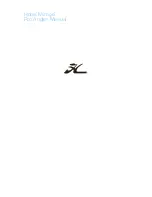
OS 315
24
and is normal. Refer to the steering manufacturer owner’s manual for specific information on the steering
system.
Dual engine outboards are coupled at the tiller arms by a tie bar. The engines must be aligned with each other
to provide maximum stability on straight ahead runs and proper tracking through corners. Engine or steering
system damage may require the engines to be realigned.
SOME AUTOPILOTS HAVE ENGINE POSITION SENSORS THAT ARE MOUNTED TO THE
HYDRAULIC STEERING CYLINDER. WITH THESE AUTOPILOTS, THE ENGINE POSI-
TION SENSOR BRACKET COULD HIT THE TRANSOM WHEN THE ENGINES ARE TILTED
TO THE FULL UP POSITION AND CAUSE DAMAGE TO THE ENGINE RIGGING, THE
AUTOPILOT OR THE TRANSOM. IF YOU HAVE AN AUTOPILOT INSTALLED ON YOUR
BOAT, YOU SHOULD MONITOR THE LOCATION OF THE ENGINE CABLES AND AUTO-
PILOT BRACKETS AS THE ENGINES ARE TILTED TO DETERMINE THE BEST ENGINE
POSITION AND MAXIMUM ENGINE TILT FOR YOUR APPLICATION.
TILT HELM
A tilt helm may be installed on the OS 315. To tilt the wheel, depress the lever located in the base of the helm.
Make sure it locks into position.
DO NOT ATTEMPT TO ADJUST THE HELM WHEEL POSITION WHILE UNDERWAY.
POWER STEERING (Optional)
The power steering system uses an electrically controlled hydraulic pump to provide power to the standard
hydraulic steering system. Additional components are a helm mounted power steering switch and a hydraulic
pump. The switch activates the power steering feature. Manual steering is always available regardless of the
switch position. Turning off the power steering at low speeds will reduce the sensitivity of the steering. To
conserve battery power, due to limited engine charging output during extended periods of slow speed
operation, the power steering should be turned off. Refer to the Teleflex® Power Assist manual for further
information.
2.9 Trim Tabs
The trim tabs are recessed into the hull on the transom. Switches are used to control the trim tabs. The switches
are labeled and control bow up and down movements. It also controls starboard and port up and down
movements. Bow up and bow down will control the hull planing attitude, while port and starboard up and
down provide control for the hull trim side to side.
Before leaving the dock, make sure that the tabs are in the full “UP” position by holding the control in the
bow "UP" position for ten (10) seconds.
Always establish the intended heading and cruise speed before attempting to adjust the hull attitude with the
trim tabs. After stabilizing speed and direction, move the trim tabs to achieve a level side to side running
attitude being careful not to over trim.
After depressing a trim tab switch, always wait a few seconds for the change in the trim plane to take effect.
Summary of Contents for OS 315
Page 2: ...OS 315 2 THIS PAGE WAS LEFT BLANK INTENTIONALLY...
Page 4: ...OS 315 4 THIS PAGE WAS LEFT BLANK INTENTIONALLY...
Page 6: ...OS 315 6 OperatorNotes...
Page 8: ...OS 315 8 OperatorNotes...
Page 10: ...OS 315 10 OperatorNotes...
Page 58: ...OS 315 58 OperatorNotes...
Page 64: ...OS 315 64 OperatorNotes...
Page 74: ...OS 315 74 OperatorNotes...
Page 90: ...OS 315 90 OperatorNotes...
Page 98: ...OS 315 98 OperatorNotes...
Page 106: ...OS 315 106 OperatorNotes...
Page 114: ...OS 315 114 THIS PAGE WAS LEFT BLANK INTENTIONALLY...
Page 116: ...OS 315 116 Hours Date Dealer Service Repairs MAINTENANCE LOG...
Page 117: ...OS 315 117 Hours Date Dealer Service Repairs MAINTENANCE LOG...
Page 118: ...OS 315 118 Hours Date Dealer Service Repairs MAINTENANCE LOG...
Page 119: ...OS 315 119 Hours Date Dealer Service Repairs MAINTENANCE LOG...
Page 120: ...OS 315 120 Hours Date Dealer Service Repairs MAINTENANCE LOG...
Page 124: ...OS 315 124 THIS PAGE WAS LEFT BLANK INTENTIONALLY...
Page 128: ...OS 315 128 THIS PAGE WAS LEFT BLANK INTENTIONALLY...
















































